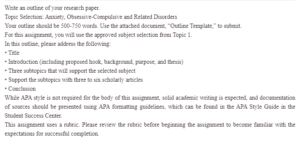Obsessive-Compulsive Disorder
Have you ever seen an individual obsessed with cleaning surfaces every two minutes? This is not normal behavior, and it is a mental disorder known as obsessive-compulsive disorder (OCD). OCD is a chronic mental disorder in which an individual has uncontrollable recurring thoughts known as obsessions and compulsions that the individual feels the urge to repeat. OCD is a mental condition that requires prompt diagnosis using the DSM-V diagnostic criteria and management using pharmacological and non-pharmacological treatments to improve quality of life.
DSM-V Diagnostic Criteria
For an individual to be diagnosed with OCD, they must meet specific criteria as outlined by the DSM-V diagnostic criteria. The first criterion is the presence of compulsions, obsessions, or both. Obsessions are defined as “recurrent and persistent images, thoughts, or urges experienced as unwanted and intrusive and those that cause marked distress or anxiety” (Stein et al., 2019). The patient attempts to suppress or ignore such images, urges, or thoughts with some other action or thought, i.e., compulsion (Stein et al., 2019). Compulsions are ” repetitive behaviors such as hand washing or mental acts such as counting that a patient feels driven to do in response to obsessions” (Stein et al., 2019). These mental acts or behaviors aim to prevent or reduce distress or anxiety (Stein et al., 2019). However, these mental acts or behaviors are not realistically connected with what they are aimed to neutralize or prevent.
The compulsions or obsessions consume a lot of time or impair social or occupational aspects (Stein et al., 2019). The third criterion is the symptoms cannot be attributed to the physiological effects of substances such as medications or medical conditions (Stein et al., 2019). The fourth criterion is that the symptoms cannot be explained by symptoms of other mental disorders, such as generalized anxiety disorder, excoriation, trichotillomania, hoarding disorder, and schizophrenia, among others (Stein et al., 2019).
Pharmacological Management
Selective serotonin reuptake inhibitors are generally first-line medications in the management of OCD, and it is associated with favorable long-term results and reasonable response rates (Del Casale et al., 2019). Most SSRIs effectively treat OCD in both the acute and maintenance phases with good tolerability (Del Casale et al., 2019). There is no significant difference in efficacy between sertraline, paroxetine, fluvoxamine, and citalopram. However, the response to SSRI treatment may be more delayed in OCD patients compared to anxiety disorders or major depression (Del Casale et al., 2019). SSRIs should be prescribed at the maximum therapeutic dose for at least one year, with dose-related treatment. The higher the doses, the better the clinical responses (Del Casale et al., 2019).
Non-pharmacological Management
The non-pharmacological treatment of choice for OCD is exposure and response prevention (ERP). The exposure exposes an individual to objects, thoughts, and images, resulting in distress and obsessions. At the same time, response prevention involves making the patient choose not to do a compulsive behavior after an obsession has been triggered (Simpson & Hezel, 2019). The therapist guides the patient, enabling them to eventually learn the EBP exercise to manage their obsessions and compulsions. ERP purposefully exposes the patient to things that give them exposure.
Conclusion
OCD is a mental disorder that causes significant distress and anxiety among individuals, and it is a common chronic disorder. The DSM-V diagnostic criteria provide a framework for OCD management, and this condition can be managed both pharmacologically and non-pharmacologically. SSRIs are the first-line medication for managing OCD, while ERP is the first-choice psychotherapy for managing OCD.
References
Del Casale, A., Sorice, S., Padovano, A., Simmaco, M., Ferracuti, S., Lamis, D. A., Rapinesi, C., Sani, G., Girardi, P., Kotzalidis, G. D., & Pompili, M. (2019). Psychopharmacological Treatment of Obsessive-Compulsive Disorder (OCD). Current Neuropharmacology, 17(8), 710–736. https://doi.org/10.2174/1570159X16666180813155017
Simpson, H., & Hezel, D. (2019). Exposure and response prevention for obsessive-compulsive disorder: A review and new directions. Indian Journal of Psychiatry, 61(7), 85. https://doi.org/10.4103/psychiatry.indianjpsychiatry_516_18
Stein, D. J., Costa, D., Lochner, C., Miguel, E. C., Reddy, Y., Shavitt, R. G., van den Heuvel, O. A., & Simpson, H. B. (2019). Obsessive-compulsive disorder. Nature reviews. Disease primers, 5(1), 52. https://doi.org/10.1038/s41572-019-0102-3
ORDER A PLAGIARISM-FREE PAPER HERE
We’ll write everything from scratch
Question

Obsessive-Compulsive Disorder
Write an outline of your research paper.
Topic Selection: Anxiety, Obsessive-Compulsive and Related Disorders
Your outline should be 500-750 words. Use the attached document, “Outline Template,” to submit.
For this assignment, you will use the approved subject selection from Topic 1.
In this outline, please address the following:
• Title
• Introduction (including proposed hook, background, purpose, and thesis)
• Three subtopics that will support the selected subject
• Support the subtopics with three to six scholarly articles
• Conclusion
While APA style is not required for the body of this assignment, solid academic writing is expected, and documentation of sources should be presented using APA formatting guidelines, which can be found in the APA Style Guide in the Student Success Center.
This assignment uses a rubric. Please review the rubric before beginning the assignment to become familiar with the expectations for successful completion.

